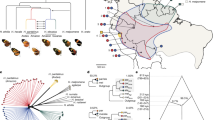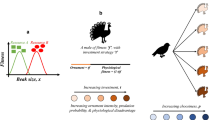Abstract
Allopatric speciation results from geographic isolation between populations. In the absence of gene flow, reproductive isolation arises gradually and incidentally as a result of mutation, genetic drift and the indirect effects of natural selection driving local adaptation1,2,3. In contrast, speciation by reinforcement is driven directly by natural selection against maladaptive hybridization1,4. This gives individuals that choose the traits of their own lineage greater fitness, potentially leading to rapid speciation between the lineages1,4. Reinforcing natural selection on a population of one of the lineages in a mosaic contact zone could also result in divergence of the population from the allopatric range of its own lineage outside the zone4,5,6. Here we test this with molecular data, experimental crosses, field measurements and mate choice experiments in a mosaic contact zone between two lineages of a rainforest frog. We show that reinforcing natural selection has resulted in significant premating isolation of a population in the contact zone not only from the other lineage but also, incidentally, from the closely related main range of its own lineage. Thus we show the potential for reinforcement to drive rapid allopatric speciation.
This is a preview of subscription content, access via your institution
Access options
Subscribe to this journal
Receive 51 print issues and online access
$199.00 per year
only $3.90 per issue
Buy this article
- Purchase on Springer Link
- Instant access to full article PDF
Prices may be subject to local taxes which are calculated during checkout




Similar content being viewed by others
References
Dobzhansky, T. Genetics and the Origin of Species 3rd edn (Columbia Univ. Press, New York, 1951)
Mayr, E. Animal Species and Evolution 548–555 (Belknap Press, Cambridge, Massachusetts, 1963)
Coyne, J. A. & Orr, H. A. Speciation (Sinauer, Sunderland, Massachusetts, 2004)
Howard, D. J. in Hybrid Zones and the Evolutionary Process (ed. Harrison, R. G.) 46–69 (Oxford Univ. Press, New York, 1993)
Littlejohn, M. J. & Loftus-Hills, J. J. An experimental evaluation of premating isolation in the Hyla ewingi complex (Anura: Hylidae). Evolution 22, 659–663 (1968)
Zouros, E. & d'Entremont, C. J. Sexual isolation among populations of Drosophila mojavensis: response to pressure from a related species. Evolution 34, 421–430 (1980)
Servedio, M. R. & Noor, M. A. The role of reinforcement in speciation: theory and data. Annu. Rev. Ecol. Evol. Syst. 34, 339–364 (2003)
Butlin, R. K. Reinforcement: an idea evolving. Trends Ecol. Evol. 10, 433–434 (1995)
Butlin, R. K. Mystery of mysteries no longer? Evolution 58, 243–245 (2004)
Butlin, R. K. & Tregenza, T. Evolutionary biology: is speciation no accident? Nature 387, 551–552 (1997)
Schneider, C. J., Cunningham, M. & Moritz, C. Comparative phylogeography and the history of endemic vertebrates in the Wet Tropics rainforest of Australia. Mol. Ecol. 7, 487–498 (1998)
Phillips, B. L., Baird, S. J. E. & Moritz, C. When vicars meet: a narrow contact zone between morphologically cryptic phylogeographic lineages of the rainforest skink, Carlia rubrigularis. Evolution 58, 1536–1549 (2004)
Noor, M. A. Reinforcement and other consequences of sympatry. Heredity 83, 503–508 (1999)
Blair, W. F. Isolating mechanisms and interspecies interactions in anuran amphibians. Q. Rev. Biol. 39, 333–344 (1964)
Gerhardt, H. C. & Huber, F. Acoustic Communication in Insects and Anurans (Univ. Chicago Press, Chicago, 2002)
Schneider, C. J. & Moritz, C. Rainforest refugia and evolution in Australia's Wet Tropics. Proc. R. Soc. Lond. B 266, 191–196 (1999)
Liou, L. W. & Price, T. D. Speciation by reinforcement of premating isolation. Evolution 48, 1451–1459 (1994)
Littlejohn, M. J. in Evolution and Speciation: Essays in Honor of M. J. D. White (eds Atchley, W. R. & Woodruff, D. S.) 298–334 (Cambridge Univ. Press, Cambridge, 1981)
Barton, N. H. & Hewitt, G. M. Adaptation, speciation and hybrid zones. Nature 341, 497–503 (1989)
Bigelow, R. S. Hybrid zones and reproductive isolation. Evolution 19, 449–458 (1965)
Sanderson, N. Can gene flow prevent reinforcement? Evolution 43, 1223–1235 (1989)
Cain, M. L., Andreasen, V. & Howard, D. J. Reinforcing selection is effective under a relatively broad set of conditions in a mosaic hybrid zone. Evolution 53, 1343–1353 (1999)
Moore, J. A. in The Species Problem (ed. Mayr, E.) 325–338 (American Association for the Advancement of Science, Washington DC, 1957)
Dolman, G. & Phillips, B. Single copy nuclear DNA markers characterized for comparative phylogeography in Australian wet tropics rainforest skinks. Mol. Ecol. Notes 4, 185–187 (2004)
Anderson, E. C. & Thompson, E. A. A model-based method for identifying species hybrids using multilocus genetic data. Genetics 160, 1217–1229 (2002)
Sokal, R. R. & Rohlf, F. J. Biometry: the Principles and Practice of Statistics in Biological Research 724–740 (W. H. Freeman, New York, 1995)
Agresti, A. Categorical Data Analysis 239–249 (Wiley, New York, 1990)
Gosner, K. A simplified table for staging anuran embryos and larvae with notes on identification. Herpetologica 16, 183–190 (1960)
Acknowledgements
We thank B. Phillips, J. MacKenzie, M. Tonione, J. Gardiner, M. Blows, J. Austin, M. Cunningham, H. McCallum, G. Dolman, S. Williams, H. Rundle, S. Chenoweth, A. Freeman, F. J. Rohlf and D. Wake. We are also grateful to B. Phillips and M. Cunningham for locating the contact zone. Supported by the National Science Foundation (C.M.), an Australian Postgraduate Award (C.J.H.), a University of Queensland Graduate School Research Travel Award (C.J.H.), the Cooperative Research Centre for Tropical Rainforest Ecology and Management (C.J.H.) and Queensland Parks and Wildlife Service.
Author information
Authors and Affiliations
Corresponding author
Ethics declarations
Competing interests
Sequences are deposited in the EMBL database under the following accession numbers: AF304205–AF304229 (ref. 11) and AJ872186–AJ872201. Reprints and permissions information is available at npg.nature.com/reprintsandpermissions. The authors declare no competing financial interests.
Supplementary information
Supplementary Methods and Results
Details of the methods and analyses, and additional analyses and results not presented in the paper. The file is broken into sub-headings matching those in the ‘Methods’ section of the main paper. Included are 9 Supplementary Tables that present the results of ANCOVAs and contrasts referred to in the Supplementary Information. (DOC 109 kb)
Supplementary Figure 1
Map showing the sampling sites outside the contact region, and the lineage (N or S) of individuals at each site. (PDF 662 kb)
Supplementary Figure 2
Map showing the sampling sites across the mosaic contact zone, and the lineage (N, S/iS or mixed) of individuals at each site. (PDF 610 kb)
Supplementary Figure 3
Graph showing variation in male size in the southern lineage. The graph compares southern lineage males at Contact B (iS), at Contact A, and outside the contact region. (DOC 24 kb)
Supplementary Figure 4
Graph showing call variation in the southern lineage. The graph compares southern lineage males at Contact B (iS), at Contact A, and outside the contact region. (DOC 24 kb)
Supplementary Figure 5
Graph showing the relationship between call divergence and body size for N, S and iS. (DOC 25 kb)
Rights and permissions
About this article
Cite this article
Hoskin, C., Higgie, M., McDonald, K. et al. Reinforcement drives rapid allopatric speciation. Nature 437, 1353–1356 (2005). https://doi.org/10.1038/nature04004
Received:
Accepted:
Issue Date:
DOI: https://doi.org/10.1038/nature04004
This article is cited by
-
Multiple contact zones and karyotypic evolution in a neotropical frog species complex
Scientific Reports (2024)
-
The first linkage map for Australo-Papuan Treefrogs (family: Pelodryadidae) reveals the sex-determination system of the Green-eyed Treefrog (Litoria serrata)
Heredity (2023)
-
Conservation genomics reveals fine-scale population structuring and recent declines in the Critically Endangered Australian Kuranda Treefrog
Conservation Genetics (2023)
-
Distribution, Population Density, and Behavior of Dwarf Galagos (Paragalago sp.) in Taita Hills, Kenya
International Journal of Primatology (2023)
-
Population transcriptomic sequencing reveals allopatric divergence and local adaptation in Pseudotaxus chienii (Taxaceae)
BMC Genomics (2021)
Comments
By submitting a comment you agree to abide by our Terms and Community Guidelines. If you find something abusive or that does not comply with our terms or guidelines please flag it as inappropriate.



